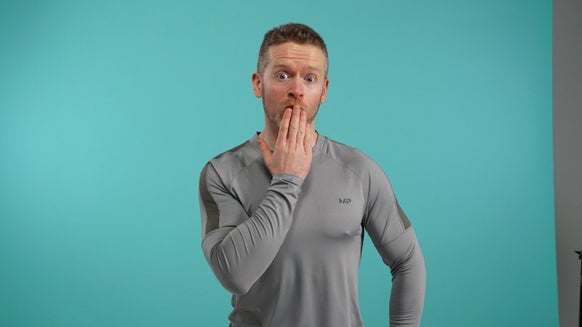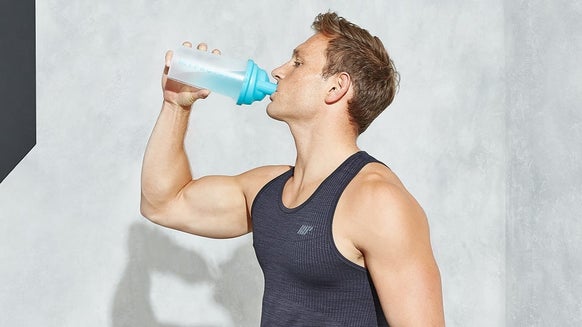Should You Train When Sore?

DOMS stands for delayed onset muscle soreness, which usually takes place 24 to 72 hours post-workout. It’s uncomfortable and usually, the last thing you’ll want to do is exercise that muscle group again. DOMS can be enough to put anyone off training, resulting in missed sessions or unproductive workouts.
It’s normal to feel some soreness from your training, assuming that you are stimulating the muscles enough for exercise induced muscle damage to occur. If you feel sore and stiff all the time with performance seemingly regressing, then you’re likely under recovering and potentially suffering from the effects of overtraining.

Training when sore: What are the benefits?
When you are feeling soreness after an exercise session (DOMS), that is a sign that your body is undergoing the required inflammatory healing process to repair damaged muscle tissue. Of course, our priority should be recovery during this period, as we want a positive training adaptation to occur. It should go without saying that you should not aim to do strenuous exercise on sore muscles when they are recovering – this is because you will shunt the recovery process, mitigating any positive adaptations. This does not, however, mean that you should not exercise at all when sore!
Increased Blood Flow
Returning to the gym for a lighter session can help to increase muscle temperature and blood circulation, helping to increase the rate at which the inflammatory healing process occurs. Ultimately, this can help to reduce the amount of time that you experience DOMS for.
Improved Mobility & Reduced Pain
When you experience DOMS, it is likely that you may feel pain and stiffness in the affected muscles. Similar to performing a warm-up prior to a session, exercising when sore can help to temporarily alleviate the symptoms of DOMS by improving joint mobility via increased muscle and joint temperature.
Training Other Muscle Groups
Exercising other muscle groups when you are experiencing DOMS in others can allow you to continue adapting to training stimulus, whilst increasing blood flow and utilising active recovery for the recovering muscles. If you were unable to train every time you had DOMS, then you wouldn’t be able to train very frequently! Ultimately, this means that you won’t need to halt training, but you should still take a day off every now and then to allow your body to recover and adapt.
Are there risks of working out when sore?
Working out while you have DOMS is not inherently dangerous, but it can certainly influence your training. At the very least, it’s unlikely that you’ll have your most productive training sessions when training fatigued or during recovery.
Increased Risk of Injury
When you are experiencing DOMS, the pain and discomfort is caused by the inflammation occurring within the muscles to repair damaged tissue. This damaged tissue is otherwise known as Exercise Induced Muscle Damage, often caused by high training volume, intensity, eccentric muscle contractions or novel stimuli. This muscle damage involves microtears within the muscle fibre, where mechanical breakdown has occurred during exercise.
While exercise in general will not be inherently dangerous while recovering from DOMS, the structural integrity of your muscle tissue is temporarily compromised, meaning you are more susceptible to muscle strains and tears. When you are recovering from DOMS, it’s wise to save the heavier weights for when you are fully recovered.
Mitigate Positive Training Adaptations
After exercise, your muscles are repaired and recover before entering a stage known as supercompensation. This is when a positive training adaptation has occurred, meaning you will be stronger or faster etc. If recovery is interrupted, such as by training too intensely while your body is trying to repair itself, then it is likely that supercompensation will be mitigated or not occur at all. Ultimately, this means you will have wasted training, as no positive training adaptations will have been made (if your goal is to simply use exercise as a means of maintaining a caloric deficit, then you are probably not as concerned about training adaptations).
Unproductive Sessions
Since you will be training while fatigued, it is unlikely that you will be able to put maximal effort into training. This may lead to you simply going through the motions, going to the gym to simply go to the gym. In this instance, it’s probably best for you to take the day off to recover more!

Why you might be sore:
Training Volume is Too High
The term Maximal Recoverable Volume (MRV) refers to the maximum amount of training volume that you can undergo and still make positive training adaptation from. It’s difficult to know where this boundary is, but if you constantly feel sore after your sessions and you feel that you never seem to recover effectively or efficiently, then you may be training with too much volume.
You can still make positive training adaptations when training above this threshold, but it means that a lot of your training is being done for no return – i.e., you’re wasting your time.
Training to Failure Too Often
This point also relates to MRV – if you are constantly inducing too much mechanical muscle damage (and significant neurological fatigue), then you will not be able to recover effectively from your training. Varying the intensity of your training sessions can help you to continue making positive training adaptations, without feeling sore. While DOMS is a sign of a muscle damage, it is not essential for an effective session!
Increased Frequency
Increasing your training will also result in a drastic increase in training volume. Not only does this introduce new stimulus to recover from, but it also reduces the amount of time you have to recover from training, resulting in sustained DOMS.
You Haven’t Taken a De-load
This is effectively a period (usually a week) where you reduce training load to allow your body to fully recover from training. If you never take a deload period, then you may not be able to recover from your training fully, and thus experience the negative effects of DOMS for a sustained period.
Insufficient Caloric/Protein Intake
You do not necessarily have to be in a caloric surplus/maintenance to recover well, but it certainly helps! Protein is also essential for repairing muscle damage, so an insufficient intake means your body will not have the building blocks needed to repair itself. Ultimately, this leads to (you guessed it!) a sustained period of DOMS, as your body cannot recover efficiently.
Not Enough Sleep
During sleep, all sorts of processes occur to repair the body and accelerate recovery. Without sufficient sleep, then we mitigate our body’s ability to produce hormones such as growth hormone, which aid in the growth and development of tissues. Unsurprisingly, this means soreness is likely to stick around for longer.
Dehydration
Research suggests that being appropriately hydrated can help to improve circulation (and thus facilitate the removal of metabolic waste/delivery of nutrients to cells). This may only slightly increase the rate at which DOMS is cleared, but it can help to alleviate acute symptoms such as soreness and stiffness.
NEAT is Too High
This point relates to caloric intake – NEAT, or Non-Exercise Activity Thermogenesis, refers to our daily activities that don’t involve exercise, but still involve being active. For instance, if your job involves a lot of walking, then your NEAT will be higher than somebody who works in an office with minimal activity. If your NEAT is too high (i.e. you/re not consuming enough calories to offset it), then you may not be consuming enough calories to also support efficient recovery from exercise, and thus DOMS remain present for longer.
Tips to avoid muscle soreness
Mobility Training/Yoga: When you are feeling sore and tight, then some light activity such as yoga can help to increase circulation, improving recovery and alleviating the sensation of tightness. This can also act as a deload from strenuous training, allowing you to improve your mobility while recovering for the next session!
Managing Recovery: As previously mentioned, taking time off from training, self-massage and sleep are all great ways of allowing your body to sufficiently recover from training. At the very least, this will reduce the severity of the DOMS you experience.
Sufficient Nutrition: Getting enough calories and protein will accelerate your recovery, providing the body with the resources it needs to repair damaged muscle fibres, mitigating or eliminating the effects of DOMS.
Managing Training: One of the easiest ways to avoid getting DOMS is to manage your training volume effectively. While DOMS is a sign of muscle damage, it is not essential for positive training adaptations to be made. For example, elite athletes will often aim to avoid getting DOMS in training so that it does not affect their performance in other areas. Managing your training effectively (e.g., introducing deload weeks) can allow your body to adapt to training at an appropriate pace.
Take Home Message
In some cases, soreness after training can be unavoidable, but it is not necessarily a bad thing. DOMS are a normal consequence of effective training and can provide a good indicator for if you are overtraining or under-recovering. By following our advice in this article, you can get the most out of your training!







